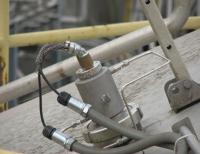Brewery product quality requires close attention to process variables throughout the production cycle. Separating trub (sediment) from a brewery’s process liquid is essential after the wort boil and after fermentation. In the latter case this is generally accomplished through various stages of separation and filtration. In the case of wort (liquid extracted during the mashing process), a whirlpool vessel is often used for separation after the boil. The wort from the upstream brewing kettle circulates within the whirlpool tank, eventually allowing solids to deposit at the center base due to centrifugal action. Afterward, the whirlpool tank is rinsed by spraying it with water from internal nozzles to flush the trub from the tank.
Problems in Trub Removal
If the flushing process is not complete, any remaining trub can pose a quality problem, for example, impart an off-flavor to the next batch, particularly if it is not the same as the previous batch. After a timed rinse cycle, operators have two choices: assume that all trub has been rinsed out of the whirlpool tank, or climb the ladder to the top of the tank and look through a sight-glass to make a determination.
The problem with the first choice is the further assumption that spray nozzles never clog and pumps and valves never fail, which is not the case. The problems with the second choice are safety issues and the time it takes to verify trub removal. While multiple rinse cycles could be automatically initiated, this too has its drawbacks. One is additional process time, and the other is excessive water usage.
One Brewery’s Solution

To solve these problems, a major U.S. brewery investigated the installation of a video camera on the whirlpool sight-glass. The idea was to connect its output to a video monitor in the control room, thereby allowing the entire whirlpool process stage to be monitored. As it happened, several installation and application variables had to be resolved before this concept could be successfully implemented. (Shown right, the camera installed in an air-cooled housing.)
the first step taken by process engineers was a discussion with operations personnel to get a thorough understanding of the whirlpool process, its key variables, and problem areas. The next step was collection of temperature data, lighting requirements, and physical dimensions associated with the proposed camera installation.
This information was then used to prepare a request for quote that was sent to several potential industrial video camera suppliers. All but one declined to submit a quote. However, L.J. Star, Inc. of Twinsburg, OH had already supplied the existing sight-glass on the whirlpool tank, and offered a video camera that could be mounted on the sight-glass assembly.
Application Environment Poses Problems
The application environment for the camera was the main factor that led other companies to decline to submit a bid. The camera must be mounted on top of the whirlpool tank, which places it outdoors and exposed to the full range of environmental conditions. In addition to heat from the sun, heat from the whirling wort is transmitted to the camera through the sight-glass assembly. This can raise the temperature of the camera housing to more than 100°C.
A Lumiglas® Model K15 VISULEX color video camera supplied by L.J. Star was installed on the existing sight-glass in the top of the whirlpool tank. A second sight-glass with a high intensity discharge lamp was installed to provide sufficient continuous illumination inside the tank for the camera. Then initial testing was conducted to see how the system performed.
Two problems were uncovered during the first few trial runs. First, condensation from the whirling wort collected on the sight-glass, obscuring the camera’s view inside the tank. Second, the temperature of the camera housing rose so high that there were periodic faults in the transmitted video image.
Camera Modifications
To solve these problems, L.J. Star technicians replaced the standard sight-glass with one that had a hydrophobic coating. This allowed the glass to shed condensation more easily. Then the camera was installed in a stainless steel air-cooled housing. Airflow (5–8 psi) was controlled by a solenoid-operated valve tied into one of the brewery’s PLC systems. The PLC logic was programmed to turn off airflow whenever there was no process activity for 8 hours.
The K15 Camera is available with either a fixed or zoom lens and has a video resolution of up to 480 TV lines. The camera’s field of view was easily adjusted to see most of the tank sidewalls as well as the bottom area where trub accumulates. Optional camera features such as automatic control of aperture, focus, and shutter speed can simplify its setup.
A camera cable of up to 500 m long allowed connection of the video output to a TV monitor in the brewery’s control room. This was standard coax cabling with a BNC-to-phono plug adapter for the LCD TV display. Electrical power to the camera and lighting was fuse-protected 120 Vac supplied from an auxiliary transformer.
Operating Results
After solving the initial problems and making the necessary camera adjustments, it became possible to monitor the entire whirlpool process from beginning to end. While monitoring the first batch after the camera went online, operators immediately identified inoperable spray nozzles, and a large area of the tank bottom that required a repeat rinse. Operators believe that this saved the following batch from being ruined, which represented a dollar value that nearly paid for the total installation cost of the camera and lighting system.
There were additional benefits of this monitoring system. Naturally, maintenance mechanics took action to resolve the nozzle plugging. Operators also identified the opportunity for water savings. They noticed that the trub for different recipes had different removal patterns. Thereafter, operators initiated water savings by shortening the trub removal rinse cycle for those recipes that allowed it.
The whirlpool tank video monitoring system has now been in operation for more than two years. No failures or other maintenance problems have been reported.




